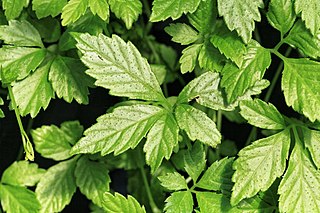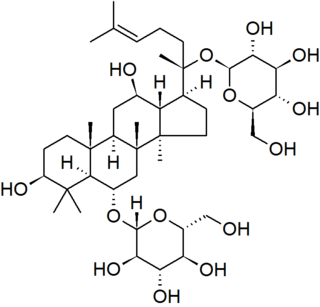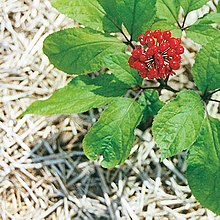
Goldenseal, also called orangeroot or yellow puccoon, is a perennial herb in the buttercup family Ranunculaceae, native to North America. It may be distinguished by its thick, yellow knotted rootstock. The stem is purplish and hairy above ground and yellow below ground where it connects to the yellow rhizome. Goldenseal reproduces both clonally through the rhizome and sexually, with clonal division more frequent than asexual reproduction. It takes between 4 and 5 years for a plant to reach sexual maturity, i.e. the point at which it produces flowers. Plants in the first stage, when the seed erupts and cotyledons emerge, can remain in this state one or more years. The second vegetative stage occurs during years two and three and is characterized by the development of a single leaf and absence of a well developed stem. Finally, the third stage is reproductive, at which point flowering and fruiting occurs. This last stage takes between 4 and 5 years to develop.

Chinese herbology is the theory of traditional Chinese herbal therapy, which accounts for the majority of treatments in traditional Chinese medicine (TCM). A Nature editorial described TCM as "fraught with pseudoscience", and said that the most obvious reason why it has not delivered many cures is that the majority of its treatments have no logical mechanism of action.

Ginseng is the root of plants in the genus Panax, such as Korean ginseng (P. ginseng), South China ginseng (P. notoginseng), and American ginseng (P. quinquefolius), characterized by the presence of ginsenosides and gintonin. Ginseng is common in the cuisines and medicines of China and Korea.

The Panax (ginseng) genus belongs to the Araliaceae (ivy) family. Panax species are characterized by the presence of ginsenosides and gintonin. Panax is one of approximately 60 plant genera with a classical disjunct east Asian and east North American distribution. Furthermore, this disjunct distribution is asymmetric as only two of the ~18 species in genus are native to North America.

Eleutherococcus senticosus is a species of small, woody shrub in the family Araliaceae native to Northeastern Asia. It may be colloquially called devil's bush, Siberian ginseng, eleuthero, ciwujia, Devil's shrub, shigoka, touch-me-not, wild pepper, or kan jang. E. senticosus has a history of use in folklore and traditional Chinese medicine. Root extracts of E. senticosus are sold as a dietary supplement or cosmetic, usually under the name Siberian ginseng.

Withania somnifera, known commonly as ashwagandha or winter cherry, is an evergreen shrub in the Solanaceae or nightshade family that grows in India, the Middle East, and parts of Africa. Several other species in the genus Withania are morphologically similar.

Gynostemma pentaphyllum, also called jiaogulan, is a dioecious, herbaceous climbing vine of the family Cucurbitaceae widely distributed in South and East Asia as well as New Guinea. Jiaogulan has recently been incorporated into traditional medicine.

Veratrum is a genus of flowering plants in the family Melanthiaceae. It occurs in damp habitats across much of temperate and subarctic Europe, Asia, and North America.

Aralia nudicaulis is a species of flowering plant in the ivy family Araliaceae. It is native to northern and eastern North America.

Pseudostellaria heterophylla, known commonly as hai er shen, tai zi shen, and false starwort, is an adaptogen in the family Caryophyllaceae that is used in Chinese medicine and herbalism to tonify the qi and generate yin fluids. It is known as the "ginseng of the lungs". The plant is a low growing plant of the pink family that is grown in Southern China in the provinces of Jiangsu, Anhui, Shandong, Heilongjiang, Jilin, Liaoning, Hebei, Henan, Shaanxi, Zhejiang, Jiangxi, Hubei, and Shanxi.

Panax notoginseng is a species of the genus Panax, and it is commonly referred to in English as Chinese ginseng or notoginseng. In Chinese it is called tiánqī, tienchi ginseng, sānqī or sanchi, three-seven root, and mountain plant. P. notoginseng belongs to the same scientific genus as Panax ginseng. In Latin, the word panax means "cure-all", and the family of ginseng plants is one of the best-known herbs.

Prunella vulgaris, the common self-heal, heal-all, woundwort, heart-of-the-earth, carpenter's herb, brownwort or blue curls, is an herbaceous plant in the mint family Lamiaceae.

Ginsenosides or panaxosides are a class of natural product steroid glycosides and triterpene saponins. Compounds in this family are found almost exclusively in the plant genus Panax (ginseng), which has a long history of use in traditional medicine that has led to the study of pharmacological effects of ginseng compounds. As a class, ginsenosides exhibit a large variety of subtle and difficult-to-characterize biological effects when studied in isolation.
Panax vietnamensis or Vietnamese ginseng is a species of the ginseng genus Panax. In Vietnam the species, prized in herbal medicine, is commercially very valuable and now considered threatened.

American ginseng is a species of flowering plant in the ivy family Araliaceae. It is native to eastern North America and introduced in China. The specific epithet quinquefolius means "five-leaved", which refers to the typical number of leaflets per leaf. It is one of a group of taxa known as "ginseng".

Angelica dahurica, commonly known as Dahurian angelica, is a widely grown species of angelica native to Siberia, Russia Far East, Mongolia, Northeastern China, Japan, Korea, and Taiwan. This species tend to grow near river banks, along streams and among rocky shrubs. The root of the plant is widely used for its medicinal properties and is known to contain furanocoumarins and angelicotoxin.

Ginseng tea, or insam-cha, is a traditional Korean tea made with ginseng. While it is called a tea, ginseng tea does not contain tea leaves. It is a herbal tea infusion made out of the ginseng plant's root. Ginseng is a perennial herb derived from the aromatic root of Panax Ginseng Meyer, also known as Korean ginseng. Ginseng grows in shady forests that are cool and damp. It is a slow-growing plant and is difficult to cultivate. It can take four to six years before the root is ready to be harvested. Ginseng roots have a forked and twisted appearance that somewhat resembles the human body.

Panax trifolius, commonly called dwarf ginseng, is a plant native to the Northeastern and Appalachian regions of North America. It is found in low mesic woods with acidic soils.
Ginseng chicken soup is a type of soup, which involves chicken and ginseng as one of the main ingredients. Ginseng can typically be cooked with chicken in broth, porridge, and soups. Varieties of ginseng chicken soup can be found in Asian countries, such as China, Malaysia, and Korea.

















